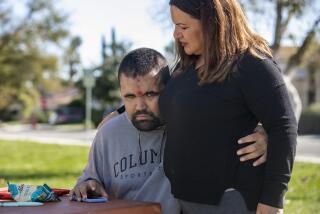Families Join to Cope With Rare Disorder
The item on Angel pitcher Bryan Harvey and his little girl caught Mark Evans’ eye. Her name is Whitney, the same as his own youngest daughter’s. And there in the brief story was a mention of a rare neurological disorder called Angelman syndrome.
Evans made a mental note; it would be another one for him and his wife, Alice, to look into.
For 10 years--a decade of doctors and tests and dead-ends--the Del Mar couple had been trying without success to find the explanation for the severe delays in their daughter’s development.
Whitney Evans, 11, is a boundlessly energetic little girl, full of a laughter that often bubbles forth for little apparent reason. Though small for her age, she can nearly bowl over an adult with one of her hugs. But she has never spoken, has suffered from severe seizures and did not take her first steps alone until she was 9.
Not long after Mark Evans saw the note mentioning Angelman syndrome in Sports Illustrated, a friend gave the couple another story, one that appeared in The Times in February. Once again, it was about Bryan Harvey and his family. The condition of Whitney Harvey, 5, Bryan and Lisa’s second child, was diagnosed as Angelman 2 1/2 years ago, and the couple are seeking to spread the word about a disorder that often goes undiagnosed or misdiagnosed.
The article in The Times was a longer one, and as the Evanses looked at the picture of Whitney Harvey and the descriptions of her behavior, their excitement grew. It was like reading about their own daughter, a girl whose problems had seemed unique in all the world.
Within weeks, the Evanses finally had an answer. Their Whitney, too, is affected by Angelman syndrome, a disorder that is caused by a deletion or other deficiency on the 15th chromosome.
By May 30, a group of eight or nine families, all with Angelman children, attended an Angel game at Anaheim Stadium. Since Harvey’s efforts to publicize the disorder began--resulting in numerous newspaper articles and television exposure--at least two children’s conditions have been diagnosed, and close to 10 Southern California families have joined a support group organized by Nancy and James Reed of Brea. Their 8-year-old daughter, Tiffany, the third of four children, was found to have Angelman about 2 1/2 years ago at Children’s Hospital of Orange County.
The Evanses, like others with Angelman children, have thick medical files filled with trips to the emergency room, prescriptions for seizure medication and a series of inaccurate diagnoses.
By coincidence, the Evanses were in the midst of another round of chromosomal analysis, taking advantage of recent technological advances, when they read about Whitney Harvey. Trying to contain their hopes and knowing that they might be disappointed yet again, they mentioned Angelman to their doctor. Soon, their guess was confirmed.
Among the typical characteristics of the syndrome--named after Dr. Harry Angelman, the British physician who first described it in 1965--are severe mental retardation, an excessively happy demeanor and the absence of meaningful speech. There is also a movement and balance disorder that results in a stiff, jerky gait. In many cases, the skin and hair of the children are very fair and sun-sensitive, and many parents have reported that the children particularly enjoy swimming and bathing. Seizures are also common.
Alice Evans, excited about finally having an answer, phoned to thank the Harveys for spreading the word about the disorder, which is frequently misdiagnosed as cerebral palsy.
Ashleigh Evans, 14, Mark and Alice’s other daughter, listened in on her mother’s half of the conversation with Lisa Harvey.
“She was saying, ‘Does your Whitney do this? So does Whitney! Same here!’ ”
Soon, the families got together, along with a third at the Harveys’ Orange County home.
“The first time we met the Harveys, that was probably the most special day of our lives,” Alice Evans said. “It was so nice, you didn’t have to worry what she might do because these kids all do the same things. It was almost like meeting a long-lost twin sister.”
Ashleigh agreed.
“It was like talking to a family member,” she said.
The gathering was just a beginning. Later in the spring, families of about eight children with the syndrome gathered at the Reeds’ home in Brea. In May, the Harveys organized the baseball outing. There were pregame visits with the players, and in a fitting end, Harvey earned the save in a 3-1 victory over Cleveland.
“It was so nice to meet other Angelman kids,” Nancy Reed said. “My husband and I had never met another Angelman child. The first meeting was kind of wild and crazy; you can imagine getting 10 of those kids together, it would be on the crazy side.”
What the families are discovering is that they are less rare than they believed.
In Santa Maria, Stephen and Alexa Morgan had been searching for the reasons for their 9-year-old Tiffany’s severe mental retardation, excessive laughter, seizures and obsession with water.
Alexa Morgan’s mother had shown her The Times story about the Harveys. And when they read about Whitney Evans in a story in the San Diego Union-Tribune, the descriptions rang true.
Alexa Morgan called Alice Evans, and soon the Morgans were confident of a diagnosis, too. As early as 1986, a doctor had noted a deletion on Tiffany Morgan’s 15th chromosome but did not make the connection to Angelman.
Now the Santa Maria Times has written a story about the Morgans, and parents applaud as word continues to spread.
Elaine Whidden, a nurse practitioner and educator in pediatric genetics at the University of Florida in Gainesville, is coordinator of the Angelman Syndrome Foundation, a support group for parents whose children have the disorder. Harvey, upon being named the American League’s top reliever last year, designated the $20,000 charitable contribution that went with the award to the group.
Whidden says one focus of the university and the foundation is trying to increase awareness of Angelman among professionals.
“We know there are a great many children--and adults, too--who have not been diagnosed. We know they’re out there,” Whidden said. “Because of a lack of knowledge--not neglect, but lack of knowledge--by medical professionals, they have not been diagnosed.”
Whidden says only about 400 North American cases of the syndrome are documented by a register at the university, though she said there are diagnosed cases that have not been reported.
As more and more has been learned about the disorder and what causes it, it has begun to become evident that Angelman might occur in as many as one of every 10,000 to 20,000 live births, Whidden said. By comparison, Down’s syndrome is estimated to occur in about one of every 1,000. Cystic fibrosis is estimated at about one in every 2,000.
There is a zeal among many of the parents to get the word out, as well as to share tips among themselves for dealing with the particular demands of caring for an Angelman child.
Perhaps no one is as qualified to offer advice as Lillian Biesiadecki, who has adult identical twin daughters with Angelman. The conditions of April and Tina, 24, were not diagnosed until 1990 with the advanced chromosome analysis.
Biesiadecki, who lives in Orange County, has not yet met with the county’s support group, but said she looks forward to giving them tips from her vast experience, as well as describing the maturation process for people with Angelman.
When others hear that Tina and April have been able to speak a few simple words-- mamma and dadda-- they are thrilled, though they know that many Angelman children never speak.
Even more remarkable, the twins have been able to work in programs for the disabled. They have folded towels at Hoag Hospital in Newport Beach and now do simple office tasks such as making copies in a Santa Ana office.
Biesiadecki and the twins’ stepfather, Richard Biesiadecki, have faced the same struggle as the others--times two.
But the twins, who are as prone as the Angelman youngsters to fits of giggling, seem to have a sense of when to be calm.
“If April is having a bad seizure, Tina will get super-duper cooperative,” Lillian Biesiadecki said. “She won’t giggle. I call it silent communication.”
Like the other parents, Biesiadecki knows what it is like to feel as if there is not another similar child in the world.
“Someone told me once, ‘One day they’ll call it Tina and April Syndrome,’ ” she said.
Being able to identify their child’s disorder--and call it by a name with such a sweet and positive connotation--has given these parents a sense of peace, even if it can’t end their children’s struggle.
“You don’t feel alone anymore,” Alexa Morgan said. “You feel very isolated when you don’t know what went wrong.”
Ashleigh Evans has taken to calling her sister, Whitney, “little Angel lady.”
And a frame discovered in a Christmas shop has become a family treasure. White ceramic surrounds Whitney’s face, with a delicate Angel on one side under these words: “Our Little Angel.”
For more information about Angelman syndrome and local support groups, contact the Angelman Syndrome Foundation, Pediatrics/Genetics, Box 100296, University of Florida Health Science Center, Gainesville, Fla., 32601-0296


